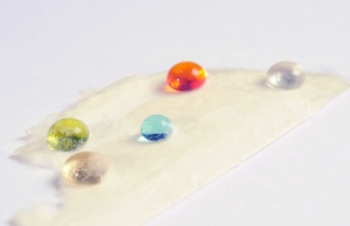May 30 2013
Paper is known for its ability to absorb liquids, making it ideal for products such as paper towels. But by modifying the underlying network of cellulose fibers, etching off surface “fluff” and applying a thin chemical coating, researchers have created a new type of paper that repels a wide variety of liquids – including water and oil.
 Droplets of water, motor oil, ethylene glycol and n-hexadecane solvent bead up on a superamphiphobic paper sample that has been prepared at the Georgia Institute of Technology. (Georgia Tech Photo: Gary Meek)
Droplets of water, motor oil, ethylene glycol and n-hexadecane solvent bead up on a superamphiphobic paper sample that has been prepared at the Georgia Institute of Technology. (Georgia Tech Photo: Gary Meek)
The paper takes advantage of the so-called "lotus effect" – used by leaves of the lotus plant – to repel liquids through the creation of surface patterns at two different size scales and the application of a chemical coating. The material, developed at the Georgia Institute of Technology, uses nanometer- and micron-scale structures, plus a surface fluorocarbon, to turn old-fashioned paper into an advanced material.
The modified paper could be used as the foundation for a new generation of inexpensive biomedical diagnostics in which liquid samples would flow along patterns printed on the paper using special hydrophobic ink and an ordinary desktop printer. This paper could also provide an improved packaging material that would be less expensive than other oil- and water-repelling materials, while being both recyclable and sustainable.
“Paper is a very heterogeneous material composed of fibers with different sizes, different lengths and a non-circular cross-section,” said Dennis Hess, a professor in the Georgia Tech School of Chemical and Biomolecular Engineering. “We believe this is the first time that a superamphiphobic surface – one that repels all fluids – has been created on a flexible, traditional and heterogeneous material like paper.”
Research leading to development of the superamphiphobic paper has been supported by the Institute for Paper Science and Technology (IPST) at Georgia Tech. Details were published online May 24 in the journal ACS Applied Materials & Interfaces.
The new paper, which is both superhydrophobic (water-repelling) and super oleophobic (oil-repelling), can be made from standard softwood and hardwood fibers using a modified paper process. In addition to Hess, the research team included Lester Li, a graduate research assistant, and Victor Breedveld, an associate professor in the School of Chemical and Biomolecular Engineering
Producing the new paper begins with breaking up cellulose fibers into smaller structures using a mechanical grinding process. As in traditional paper processing, the fibers are then pressed in the presence of water – but then the water is removed and additional processing is done with the chemical butanol. Use of butanol inhibits the hydrogen bonding that normally takes place between cellulose fibers, allowing better control of their spacing.
“The desirable properties we are seeking are mainly controlled by the geometry of the fibers,” Hess explained.
The second step involves using an oxygen plasma etching process – a technique commonly used in the microelectronics industry – to remove the layer of amorphous “fluffy” cellulose surface material, exposing the crystalline cellulose nanofibrils. The process thereby uncovers smaller cellulose structures and provides a second level of “roughness” with the proper geometry needed to repel liquids.
Finally, a thin coating of a fluoropolymer is applied over the network of cellulose fibers. In testing, the paper was able to repel water, motor oil, ethylene glycol and n-hexadecane solvent.
The researchers have printed patterns onto their paper using a hydrophobic ink and a desktop printer. Droplets applied to the pattern remain on the ink pattern, repelled by the adjacent superamphiphobic surface.
That capability could facilitate development of inexpensive biomedical diagnostic tests in which a droplet containing antigens could be rolled along a printed surface where it would encounter diagnostic chemicals. If appropriate reagents are used, the specific color or color intensity of the patterns could indicate the presence of a disease. Because the droplets adhere tightly to the printed lines or dots, the samples can be sent to a laboratory for additional testing.
“We have shown that we can do the operations necessary for a microfluidic device,” Hess said. “We can move the droplet along a pattern, split the droplet and transfer the droplet from one piece of paper to another. We can do all of these operations on a two-dimensional surface.”
For Hess, Li and Breedveld, creating a superhydrophobic suface was relatively straightforward because water has a high surface tension. For oils, which have a low surface tension, the key to creating the repellent surface is to create re-entrant – or undercut – angles between the droplets and the surface.
Previous examples of superamphiphobic surfaces have been made on rigid surfaces through lithographic techniques. Such processes tend to produce fragile surfaces that are prone to damage, Hess said.
The principal challenge has been to create high-performance in a material that is anything but geometrically regular and consistent.
“Working with heterogeneous materials is fascinating, but it’s very difficult not just to control them, because there is no inherent consistent structure, but also to change the processing conditions so you can get something that, on average, is what you need,” he said. “It’s been a real learning experience for us.”
The new paper has so far been made in samples about four inches on a side, but Hess sees no reason why the process couldn’t be scaled up. Though long-term testing of the new paper hasn’t been done, Hess is encouraged by what he’s seen so far.